#bertrade de montfort
Photo

(Chroniques de France ou de St Denis; Bertha of Holland, Bertrade de Montfort, Philippe I of France, and Foulques IV of Anjou, 14th century)
#international gothic#philip i of france#house of capet#medieval#bertrade de montfort#bertha of holland#art#art history
8 notes
·
View notes
Text
"To all intents and purposes she may be counted among the kings of France"

The hour that struck the death of Louis VIII was arguably the most critical in the history of the Capetian family. The new king, one day to be St Louis, was still a child. The trend of events in the previous two reigns had brought the higher nobility to realise that its independence would soon be seriously threatened. But a unique opportunity was raised to the regency of the queen-mother, Blanche of Castile, on the pretext that she was a woman and a foreigner. Yet this was not the first occasion on which the king's widow had acted as regent, nor the first on which a queen had played a part in politics. Philip Augustus had been the first Capetian not to involve his wife in the government of his realm. Before his time the queens of France had often intervened in affairs of state. Constance of Arles, not content with making married life difficult for Robert the Pious, had wanted to change the order of succession to the throne. She had led the opposition to Henri I, provoking and upholding his brothers against him, and she was perhaps responsible for the separation of Burgundy from the royal domain, to which Robert the Pious had joined it. Anna of Kiev, after the death of her husband Henri I, had been one of the regents, and it was only her second marriage, to Raoul de Crépy, that took her out of politics. Bertrada de Montfort's influence over Philip I had been notorious, and so had her hostility to the heir to the throne, whom she had even been accused of trying to poison. Adelaide of Maurienne, despite a physical personality before which Count Baldwin III of Hainault is said to have recoiled, had held considerable sway over Louis VI, procuring the disgrace of the chancellor, Etienne de Garlande, and egging on Louis to the Flemish adventure from which her brother-in-law, William Clito, was to profit so much. Eleanor of Aquitaine- as St Bernard had complained- had more power than anyone else over Louis VII as long as their marriage lasted. Louis VII's third wife, Adela of Champagne, had appealed to the king of England for help against her son Philip Augustus when he had sought to free himself of the tutelage of her brothers of Champagne. Later, reconciled with Philip, Adela had been regent during his absence from France on crusade. From the beginnings of Capet rule, the queens of France had enjoyed substantial influence over their husbands and over royal policy.
But Blanche of Castile was to play a greater role than any of her predecessors. To all intents and purposes she may be counted among the kings of France. For from 1226 until her death in 1252 she governed the kingdom. Twice she was regent: from 1226 to 1234, while Louis IX was a minor, and from 1248 to 1252 during his first absence on crusade. Between 1234 and 1248 Blanche bore no official title, but her power was no less effective. Severe in personality, heroic in stature, this Spanish princess took control of the fortunes of the dynasty and the kingdom in outstandingly difficult circumstances. For in 1226 there arose the most redoubtable coalition of great barons which the House of Capet ever had to face. Loyalty to the crown, so constant a feature of the past, seemed to be in eclipse. This was at any rate true of the barons who revolted, for they appear to have tried to seize the person of the young king himself- an attempt without parallel in Capetian history.
Blanche of Castile threw herself energetically into the struggle over her son and his throne. Taking her father-in-law, Philip Augustus, as her model, she won over half her enemies by craft, vigorously gave battle to the rest, and enlisted the alliance of the Church, including the Pope himself, and of the burgess class, which in marked fashion took the side of the royal family. Blanche was able to fend off Henry III of England, who tried to take the opportunity of recovering his ancestral lands, lost by John to Philip Augustus. She broke up the baronial coalition and reduced to submission the most dangerous of the rebels, Peter Mauclerc, Count of Brittany, and Raymond VII, Count of Toulouse. She adroitly took advantage of her victory to re-establish- this time definitively- the royal power in the south of France: her son Alphonse was married to the daughter and heiress of Raymond of Toulouse. The way was now open for the union of all Raymond's rich patrimony with the royal domain.
The Capetian monarchy emerged all the stronger from a crisis which had threatened to overwhelm it. Blanche felt it her duty not to rest on her laurels. After her son came of age she continued to make herself responsible for good and stable government. By the force of her example she drove home the lessons which Philip Augustus seems to have wanted to press upon his grandson when they had talked together. To Blanche's initiative must be credited the measures taken to suppress the dangerous revolt of Trencavel in Languedoc, as also those taken to defeat the coalition broken up after the battle of Saintes. On these occasions Louis IX did no more than carry out his mother's policy. When he went off on crusade, Blanche one more officially shouldered the government of the kingdom. She maintained law and order, prevented the further outbreak of war with England, and successfully pressed on with the policy which was to lead to the annexation of Languedoc. Likewise it was she who refurnished her son's crusade with men and money, and she took all the steps necessary for the safety of the kingdom when Louis was captured in Egypt.
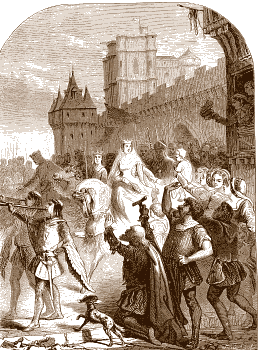
Robert Fawtier- The Capetian Kings of France- Monarchy and Nation (987-1328)
#xiii#robert fawtier#the capetian kings of france#blanche de castille#queens of france#regents#louis viii#louis ix#philippe ii#constance d'arles#robert ii#henri i#anne de kiev#philippe i#bertrade de montfort#adélaïde de savoie#louis vii#étienne de garlande#st bernard#aliénor d'aquitaine#adèle de champagne
4 notes
·
View notes
Text
was reading the list of excommunications up to the 16th cent the other night and:
Philip first married Bertha of Holland in 1072.[5] Although the marriage produced the necessary heir, Philip fell in love with Bertrade de Montfort, the wife of Fulk IV, Count of Anjou. He repudiated Bertha (claiming she was too fat) and married Bertrade on 15 May 1092.[6] In 1094 following the synod of Autun, he was excommunicated by the papal representative, Hugh of Die, for the first time;[7] after a long silence, Pope Urban II repeated the excommunication at the Council of Clermont in November 1095.
funny to me for a number of reasons, given that 1) this is how many discuss henry viii and the GM, even tho this is not what happened, at all, 2) just like...idk. like, i get it, his first wife has had her life adapted and dramatized so much more than this woman, that's why people have more of an emotional connection to her, but she is hardly the only woman to have been repudiated by her royal husband in history, preceding and after, and she's spoken of as if she was.
#they both had spouses alive and still just... ? just .#it's like if henry married bessie blount after she'd lived with her husband for three years.#if henry had a surviving son by koa by the time of the GM i would understand the outrage more but as it was...contextually the outrage#strikes me as nonsensical. or just from one absent of any background in royal history#altho many insist if he had not had a wife in mind then they would think it's reasonable which is kind of like#is it a moral outrage or not.........#and is also kind of like. well#say he had chosen a woman of charles v's family or the valois family to marry instead of AB#there would have still been opposition to either one. not everyone was for some sort of renewal of anglo-imperial alliance#not everyone was for a french alliance
3 notes
·
View notes
Text
Bertrade de Montfort had been posted off to France in charge of her mother
http://dlvr.it/SlSSFz
0 notes
Photo

O Concílio de Clermont foi um sínodo misto de eclesiásticos e leigos da Igreja Católica Romana, iniciado em 18 Novembro de 1095 e encerrando em 28 de Novembro de 1095, desencadeando a Primeira Cruzada. Em 1095, o imperador bizantino Alexius I Comnenus enviou emissários ao oeste solicitando assistência militar contra os turcos seljúcidas. A mensagem foi recebida pelo Papa Urbano II no Concílio de Piacenza; no final daquele ano, em novembro, Urbano convocou o Conselho de Clermont para discutir mais a fundo o assunto. Ao convocar o concílio, Urbano exortou os bispos e abades a quem se dirigia diretamente a trazerem consigo os senhores proeminentes de suas províncias. O Concílio durou de 18 a 28 de novembro e contou com a presença de cerca de 300 clérigos de toda a França. Urbano discutiu as reformas clunianas da Igreja e também estendeu a excomunhão de Filipe I da França por seu novo casamento adúltero com Bertrade de Montfort. Em 27 de novembro, Urbano falou pela primeira vez sobre os problemas do leste, ao declarar bellum sacrum contra os muçulmanos que ocupavam a Terra Santa. Existem seis fontes principais de informação sobre esta parte do conselho: o anônimo Gesta Francorum ("Os Feitos dos Francos") influenciando outros: Fulcher de Chartres, Robert the Monk, Baldric, arcebispo de Dol, e Guibert de Nogent, que aparentemente estiveram presentes no conselho; também sobreviveu uma carta escrita pelo próprio Urbano em dezembro de 1095. Continua nos comentários _______ Fonte - Helen J. Nicholson, The Crusades Somerville, Robert, "The Council of Clermont and the First Crusade" #curitiba #idademedia #cruzada #crusade #clermont #cwb #medieval #historia #medievalworld #medievaltimes #middleages #history #deusvult #historiamedieval https://www.instagram.com/p/ClGeIR_t5TF/?igshid=NGJjMDIxMWI=
#curitiba#idademedia#cruzada#crusade#clermont#cwb#medieval#historia#medievalworld#medievaltimes#middleages#history#deusvult#historiamedieval
0 notes
Text
Team Bertrade de Montfort badge

Team Bertrade de Montfort 6 Cm Round Badge
by CreativeHistory
#Bertrade de Montfort#Queen of France#French Queen#scandal#history#French history#French monarchy#women in history#medieval#Angevin#Fulk of Anjou#Capet#Capetian
0 notes
Text
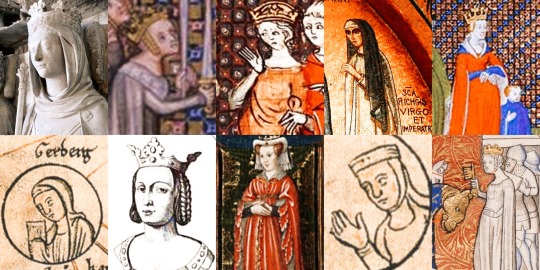
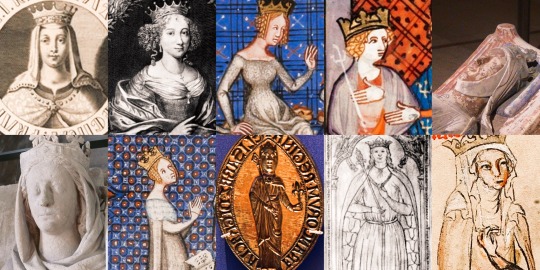




Every Queen of France Ever
Other posts in this series: Every Queen of England ever, Every English Princess ever
Richilde of Provence - Queen consort of West Francia from 870 to 877 (wife of Charles the Bald)
Adelaide of Paris - Queen consort of West Francia from October 6th 877 to April 10th 879 (wife of Louis the Stammerer)
Richardis of Swabia - Queen consort of West Francis from 884 to 887 (wife of Charles the Fat)
Richardis of Swabia - Queen consort of West Francis from 884 to 887 (wife of Charles the Fat)
Théodrate of Troyes - Queen consort of West Francia from 888 to 898 (wife of Odo of France)
Frederuna - Queen consort of West Francia from 907 to 917 (wife of Charles the Simple)
Eadgifu of Wessex - Queen consort of West Francia from 919 to 922 (wife of Charles the Simple)
Beatrice of Vermandois - Queen consort of West Francia from 922 to 923 (wife of Robert I)
Emma of France - Queen consort of West Francia from 923 to 935 (wife of Rudolph of France)
Gerberga of Saxony - Queen consort of West Francia from 939 to 954 (wife of Louis IV)
Emma of Italy - Queen consort of West Francia from 965 to 986 (wife of Lothair of France)
Adelaide of Aquitaine - Queen consort of the Franks from 987 to 996 (wife of Hugh Capet)
Rozala of Italy - Queen consort of the Franks from 996 to 996 (wife of Robert II)
Bertha of Burgundy - Queen consort of the Franks from 996 to 1000 (wife of Robert II)
Constance of Arles - Queen consort of the Franks from 1001 to 1031 (wife of Robert II)
Matilda of Frisia - Queen consort of the Franks from 1034 to 1044 (wife of Henry I)
Anne of Kiev - Queen consort of the Franks from May 19th 1051 to August 4th 1060 (wife of Henry I)
Bertha of Holland - Queen consort of the Franks from 1072 to 1092 (wife of Philip I)
Bertrade de Montfort - Queen consort of the Franks from May 15th 1092 to July 29th 1108 (wife of Philip I)
Adelaide of Maurienne - Queen consort of the Franks from 1115 to August 1st 1137 (wife of Louis VI)
Eleanor of Aquitaine - Queen consort of the Franks from August 1st 1137 to March 21st 1152 (wife of Louis VII)
Constance of Castile - Queen consort of the Franks from 1154 to October 4th 1160 (wife of Louis VII)
Adela of Champagne - Queen consort of the Franks from November 13th 1160 to September 18th 1180 (wife of Louis VII)
Isabella of Hainault - Queen consort of France from April 28th 1180 to March 15th 1190 (wife of Philip II)
Ingeborg of Denmark - Queen consort of France from August 15th 1193 to November 5th 1193 (wife of Philip II
Agnes of Merania - Queen consort of France from 1196 to 1200 (wife of Philip II)
Ingeborg of Denmark - Queen consort of France from 1200 to July 14th 1223 (wife of Philip II)
Blanche of Castile - Queen consort of France from July 14th 1223 to November 1226 (wife of Louis VIII)
Margaret of Provence - Queen consort of France from May 27th 1234 to August 25th 1270 (wife of Louis IX)
Isabella of Aragon - Queen consort of France from August 25th 1270 to January 28th 1271 (wife of Philip III)
Marie of Brabant - Queen consort of France from August 21st 1274 to October 5th 1285 (wife of Philip III)
Joan I of Navarre - Queen consort of France from October 5th 1285 to April 2nd 1305 (wife of Philip IV)
Margaret of Burgundy - Queen consort of France from 1314 to 1315 (wife of Louis X)
Clementia of Hungary - Queen consort of France from August 19th 1315 to June 5th 1316 (wife of Louis X)
Joan II of Burgundy - Queen consort of France from 1316 to 1322 (wife of Philip V)
Blanche of Burgundy - Queen consort of France from January 3rd 1322 to May 19th 1322 (wife of Charles IV)
Marie of Luxembourg - Queen consort of France from September 21st 1322 to March 26th 1324 (wife of Charles IV)
Joan of Évreux - Queen consort of France from July 5th 1324 to February 1st 1328 (wife of Charles IV)
Joan of Burgundy - Queen consort of France from April 1st 1328 to December 12th 1349 (wife of Philip VI)
Blanche of Navarre - Queen consort of France from January 29th 1350 to August 22nd 1350 (wife of Philip VI)
Joan I of Auvergne - Queen consort of France from 1350 to 1360 (wife of John II)
Joanna of Bourbon - Queen consort of France from April 8th 1364 to February 6th 1378 (wife of Charles V)
Isabeau of Bavaria - Queen consort of France from July 17th 1385 to October 21st 1422 (wife of Charles VI)
Marie of Anjou - Queen consort of France from December 18th 1422 to July 14th 1461 (wife of Charles VII)
Charlotte of Savoy - Queen consort of France from July 22nd 1461 to August 30th 1483 (wife of Louis XI)
Anne of Brittany - Queen consort of France from December 6th 1491 to April 7th 1498 (wife of Charles VIII)
Joan of France - Queen consort of France from April 1498 to December 15th 1498 (wife of Louis XII)
Anne of Brittany - Queen consort of France from January 8th 1499 to January 9th 1515 (wife of Louis XII)
Mary Tudor - Queen consort of France from October 9th 1514 to January 1st 1515 (wife of Louis XII)
Claude of France - Queen consort of France from January 1st 1515 to July 20th 1524 (wife of Francis I)
Eleanor of Austria - Queen consort of France from July 4th 1530 to March 31st 1547 (wife of Francis I)
Catherine de' Medici - Queen consort of France from March 31st 1547 to July 10th 1559 (wife of Henry II)
Mary Stuart - Queen consort of France from July 10th 1559 to December 5th 1560 (wife of Francis II)
Elisabeth of Austria - Queen consort of France from November 26th 1570 um May 30th 1574 (wife of Charles IX)
Louise of Lorraine - Queen consort of France from February 15th 1575 to August 2nd 1589 (wife of Henry III)
Margaret of Valois - Queen consort of France from August 2nd 1589 to 1599 (wife of Henry IV)
Marie de' Medici - Queen consort of France from December 17th 1600 to May 14th 1610 (wife of Henry IV)
Anne of Austria - Queen consort of France from November 24th 1615 to May 14th 1643 (wife of Louis XIII)
Maria Theresa of Spain - Queen consort of France from June 9th 1660 to July 30th 1683 (wife of Louis XIV)
Marie Leszczyńska - Queen consort of France from September 4th 1725 to June 24th 1768 (wife of Louis XV)
Marie Antoinette - Queen consort of France from May 10th 1774 to September 21st 1792 (wife of Louis XVI)
Maria Amalia of Naples and Sicily - Queen consort of the French from August 9th 1830 to February 24th 1848 (wife of Louis Philippe I)
#historical women#french history#anne of brittany#mary tudor queen of france#claude of france#eleanor of austria#eleanor of aquitaine#catherine de medici#mary queen of scots#marie antoinette
64 notes
·
View notes
Note
This may be super random but why do mediveal period dramas rarely include plump women unless they’re more a background charcater and stereotyped as Middle aged and “ugly”? Wouldn’t more bigger women be more common in those times? Or were teens/20’s high born women relatively slim?
That’s due to conventional standards. Always remember that pieces of media will always be tailored to the audience, especially when it comes to things like casting. Heck, plenty of things actually are unrealistic, but popular depictions have always used such depictions to the point where an accurate depiction actually causes the audience to say “that’s not how (x) works.”
What little I know about historical philosophy regarding obesity tends to revolve around the idea of obesity interfering with a person’s function, whether that was work or military service. I know that gluttony was considered one of the Seven Deadly Sins in the Catholic Church and the Church would increasing morally condemn fat as a means of correcting the morals of the people. (as opposed to size for other reasons - it’s important to note that in the Middle Ages the idea of overweightness being directly related to overeating and the difference in a large frame, large muscles, and obesity were well-understood), so that by the 12th century, you had moral lessons about gluttony as the Church became proselytizing more to the laity.
I’d ask people who have studied depictions of women throughout history, or if they see this, to add what they know. I know that King Phillip I used obesity to repudiate his wife as a cause of her infertility, but of course, he was too obese to ride normal horses, which could mean that he was either using it as an excuse because he was attracted to Bertrade de Montfort or it’s another example of a glaring double standard.
Thanks for the question, Anon.
SomethingLikeALawyer, Hand of the King
10 notes
·
View notes
Text
Jour 28 - La Femme au temps des cathédrales, Régine Pernoud
C’était un de ces livres qui, sans que rien ne le justifie, avait patienté des années sur une étagère après son acquisition. Quand je me suis finalement décidée à le sortir, cela faisait des années qu’il était là, je ne me souvenais plus du moment de son achat, et sa lecture m’a réjouie.
Très facile d’accès, il m’a fait croiser une galerie de personnages que j’étais loin de soupçonner et qui m’ont paru hautement sympathiques. Régine Pernoud nous raconte autant l’histoire des femmes de l’époque (documentée, vérifiée) que leur légende (celle qui frappe la mémoire et constitue un corpus d’héroïnes ou simplement de modèles). Racontant comment une querelle entre deux comtesses s’envenima jusqu’à mener leurs époux à la guerre féodale, elle raconte que l’une des deux n’hésite pas à elle-même endosser l’armure :
« Celle-ci (Isabelle) a les faveurs du chroniqueur qui raconte avec admiration qu’elle ne craignait pas d‘endosser la cotte de mailles et de combattre à cheval comme un homme : « elle ne le cédait en intrépidité ni aux chevaliers couverts de leur haubert, ni aux soldats armés de javelots. » Et de poursuivre, dans un style nourri de réminiscences antiques : « Elle égala Lampédone et Margésippe, Hippolyte et Penthésilée, et les autres reines guerrières des Amazones (…) »
Les seuls noms de ces femmes me fait voyager dans le temps. Dhuoda, longtemps connue des seuls spécialistes, est l’autrice du premier traité d’éducation, Manuel pour mon fils (composé au milieu du IXème siècle)_. _Pétronille de Chemillé, abbesse de Fontevraud à seulement vingt-deux ans. Bertrade de Montfort, qui vient se retirer dans l’abbaye en emmenant avec elle la réputation scandaleuse de ses amours illégitimes.
« Pendant des années, les jeunes Français ont appris à l’école que le plus ancien traité d’éducation était dû à Rableais, suivi de près par Montaigne. Personne ne s’avisait de leur parler de Dhuoda.
Et pour cause : le nom de Dhuoda n’a été pendant fort longtemps connu que de rares spécialistes du haut Moyen Âge. Aujourd’hui, son Manuel pour mon fils est traduit et publié dans une édition commode (…) C’est (…) le plus ancien traité d’éducation, puisqu’il fut composé au milieu du IXè siècle. »
On aborde l’émergence de la figure de la religieuse, avec notamment de longs passages concernant les abbesses de Fontevraud ; la notion de l’amour courtois et le rôle du mariage chrétien dans l’évolution du statut de la femme ; on suit Aliénor d’Aquitaine et Jeanne d’Arc ; et on parle aussi des femmes pas toujours si anonymes des villes et campagnes, qui travaillent comme paysannes, tisserandes, coiffeuses voire forgerons - citant François Villon « Jeanneton la chaperonnière, Catherine la boursière, Blanche la savetier et Guillemette la tapissière, sans autrement nommer la gantière et la saucissière (…) »
« L’éventail des professions accessibles aux femmes, tout au moins durant la période féodale proprement dite, jusqu’au XIVè siècle, incidemment plus tard encore, serait donc plus ouverte que nous n’aurions tendance à le penser, certainement plus qu’au XIXè siècle en tout cas. »
Un livre riche qui parvient à croquer pour le lecteur non-spécialiste un tableau vivant, nourri et bien plus nuancé de la période que ce que les a-priori pourraient avoir ancré en nous.
La Femme au temps des cathédrales, Régine Pernoud. Editions Stock, 1980.
Régine Pernoud est une historienne médiéviste française, née le 17 juin 1909 à Château-Chinon (Nièvre) et morte le 22 avril 1998 à Paris. En 1935, elle soutient sa thèse de doctorat en histoire médiévale à la Sorbonne. Elle publie son premier livre, Lumière du Moyen Âge, en 1946. En 1947, elle devient, enfin, conservatrice du musée de Reims puis, en 1949, conservatrice des Archives nationales et du musée de l'Histoire de France. Autrice de nombreux ouvrages destinés à un large public, elle écrit « en tant qu'historienne, je me suis lancé un défi : transmettre dans un langage simple ce que j'avais découvert par des recherches difficiles ». En plus de grandes figures féminines du Moyen Âge, Pernoud va porter ses intérêts de recherche sur la condition féminine elle-même.

#livre#histoire#vulgarisaiton#moyen-age#régine pernoud#biographies#medieval#féminisme#empouvoirment#femmes#vies de femmes#légende#héroines#365dayproject#livres de femmes#chronique#blog#garance coggins
5 notes
·
View notes
Photo
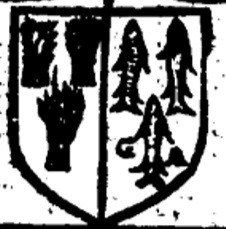
Arms of Hugh de Kevelioc, Earl of Chester 1153-1181 (1147-1181) and 'Beatrix Lucye'
From p43 of Lacies Nobilitie by Sir John Ferne (1586)
Blazon: Per pale baron and femme; the first azure three garbs or, the second gules three lucies hauriant argent
Ferne seems to include Hugh mostly to castigate him for his role in revolting against Henry II in 1173. Once again, Ferne's information on the wife seems to be inaccurate; Kevelioc married Bertrade de Montfort, who seems to have been a French noblewoman (at least, her grandfather certainly held land in Normandy). However, Ferne clearly believes that Kevelioc married into the Lucy family, regardless of the fact that Kevelioc's granddaughter Margaret de Quincy's later married into the same family.
1 note
·
View note
Photo
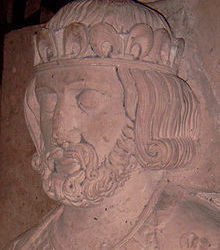
Today in history, July 29, 1108: the death of Philip I:
"Philip I (23 May 1052 – 29 July 1108), called the Amorous, was King of the Franks from 1060 to his death. His reign, like that of most of the early Capetians, was extraordinarily long for the time. The monarchy began a modest recovery from the low it reached in the reign of his father and he added to the royal demesne the Vexin and Bourges.
Philip was born 23 May 1052 at Champagne-et-Fontaine, the son of Henry Iand his wife Anne of Kiev. Unusual at the time for Western Europe, his name was of Greek origin, being bestowed upon him by his mother. Although he was crowned king at the age of seven, until age fourteen (1066) his mother acted as regent, the first queen of France ever to do so. Baldwin V of Flandersalso acted as co-regent.
Following the death of Baldwin VI of Flanders, Robert the Frisian seized Flanders. Baldwin's wife, Richilda requested aid from Philip, who defeated Robert at the battle of Cassel in 1071.
Philip first married Bertha in 1072. Although the marriage produced the necessary heir, Philip fell in love with Bertrade de Montfort, the wife of Fulk IV, Count of Anjou. He repudiated Bertha (claiming she was too fat) and married Bertrade on 15 May 1092. In 1094, he was excommunicated by Hugh of Die, for the first time; after a long silence, Pope Urban II repeated the excommunication at the Council of Clermont in November 1095. Several times the ban was lifted as Philip promised to part with Bertrade, but he always returned to her, but in 1104 Philip made a public penance and must have kept his involvement with Bertrade discreet. In France, the king was opposed by Bishop Ivo of Chartres, a famous jurist.
Philip appointed Alberic first Constable of France in 1060. A great part of his reign, like his father's, was spent putting down revolts by his power-hungry vassals. In 1077, he made peace with William the Conqueror, who gave up attempting the conquest of Brittany. In 1082, Philip I expanded his demesne with the annexation of the Vexin. Then in 1100, he took control of Bourges.
It was at the aforementioned Council of Clermont that the First Crusade was launched. Philip at first did not personally support it because of his conflict with Urban II. Philip's brother Hugh of Vermandois, however, was a major participant.
Philip died in the castle of Melun and was buried per request at the monastery of Saint-Benoît-sur-Loire – and not in St Denis among his forefathers. He was succeeded by his son, Louis VI, whose succession was, however, not uncontested. According to Abbot Suger:
'… King Philip daily grew feebler. For after he had abducted the Countess of Anjou, he could achieve nothing worthy of the royal dignity; consumed by desire for the lady he had seized, he gave himself up entirely to the satisfaction of his passion. So he lost interest in the affairs of state and, relaxing too much, took no care for his body, well-made and handsome though it was. The only thing that maintained the strength of the state was the fear and love felt for his son and successor. When he was almost sixty, he ceased to be king, breathing his last breath at the castle of Melun-sur-Seine, in the presence of the [future king] Louis... They carried the body in a great procession to the noble monastery of St-Benoît-sur-Loire, where King Philip wished to be buried; there are those who say they heard from his own mouth that he deliberately chose not to be buried among his royal ancestors in the church of St. Denis because he had not treated that church as well as they had, and because among so many noble kings his own tomb would not have counted for much.'"
#today in history#On This Day in History#death#philip i#philip I of france#philippe I of France#philippe i
3 notes
·
View notes
Photo








Women of the Crusader States || The Reigns of Baudouin II and Mélisende + Foulques
Morphia of Melitene
(unknown – c. 1126/7) Daughter of Khoril of Melitene. Wife of Baudouin II de Jérusalem. Mother of Mélisende, Alix, Hodierne, and Yvette de Jérusalem.
Mélisende de Jérusalem
(1105 – 11 September 1161) Daughter of Baudouin II de Jérusalem and Morphia of Melitene. Wife of Foulques V, comte d’Anjou. Mother of Baudouin III and Amaury de Jérusalem. Grandmother of Baudouin IV, Sibylle, and Isabelle Ire de Jérusalem.
Alix de Jérusalem
(c. 1110 – after 1136) Daughter of Baudouin II de Jérusalem and Morphia of Melitene. Wife of Bohémond II, prince d’Antioche. Mother of Constance, princesse d’Antioche. Grandmother of Bohémond III, prince d’Antioche; Marie d’Antioche, Byzantine Empress; Philippa d’Antioche, dame de Toron; Baudouin d’Antioche; and Agnès d’Antioche, magyar királyné.
Hodierne de Jérusalem
(c. 1110 – c. 1164) Daughter of Baudouin II de Jérusalem and Morphia of Melitene. Wife of Raymond II, comte de Tripoli. Mother of Raymond III, comte de Tripoli and Mélisende de Tripoli.
Yvette de Jérusalem
(c. 1118 – 1178) Daughter of Baudouin II de Jérusalem and Morphia of Melitene. Abbess of Bethany.
Beatrice Rubinyan
(1075 – c. 1130) Daughter of Kostandin I, Lord of Armenian Cilicia and an unnamed great-granddaughter of Bardas Phokas. Wife of Josselin Ier de Courtenay, comte d’Édesse. Mother of Josselin II de Courtenay, comte d’Édesse. Grandmother of Agnès de Courtenay, Josselin III de Courtenay, and Isabelle de Courtenay.
Cécile de France
(1097 – 1145) Daughter of Philippe Ier de France and Bertrade de Montfort. Wife of Tancrède de Hauteville, prince de Galilée and Pons de Saint-Gilles, comte de Tripoli. Mother of Raymond II, comte de Tripoli. Grandmother of Raymond III, comte de Tripoli and Mélisende de Tripoli.
Helvis de Rama
(c. 1110 – aft. 1152) Daughter of Baudouin Ier, seigneur de Rama and Stéphanie, dame de Naplouse. Wife of Barisan d’Ibelin, seigneur de Rama. Mother of Hugues d’Ibelin, seigneur de Rama; Baudouin d’Ibelin; seigneur de Rama; Balian d’Ibelin, seigneur de Naplouse; and Ermengarde d’Ibelin.
#historyedit#crusader states#crusades#french history#asian history#european history#medieval#history#women of the crusader states#nanshe's graphics
77 notes
·
View notes
Text
An absence of family strife
Their marriages were generally fruitful and, what was equally important, their sons were usually loyal, or at least obedient. There are remarkably few instances of rebellion against paternal authority. Robert the Pious did take arms against his father, probably in 996, and his own two sons Henri and Robert united against him in 1030; but these were isolated instances. The only other example that can be offered is the quarrel between Philip I and the future Louis VI, which may be attributed to the malicious intervention of the prince's stepmother, Queen Bertrada. If it demonstrates anything, it shows the patience and loyalty of Prince Louis under considerable provocation. No contemporary royal, or even noble, family, can show anything approaching so favourable a record in this respect.
The characters of the individual kings go some way towards explaining this absence of family strife. The Capetians were good husbands. Only two bastards are recorded for the fourteen kings of the dynasty: Isabella, daughter of Louis VI, who married Guillaume de Chaumont, and Pierre Charlot, the son of Philip Augustus and that 'damsel of Arras' whose name the chroniclers delicately omit. Only three scandals can be pointed to: the elopement of Philip I with Bertrada de Montfort, wife of Fulk of Anjou, on 15 May 1092; the estrangement of Philip Augustus and Ingeborg of Denmark in 1193; and the tragic episode of the daughters-in-law of Philip the Fair in 1314. The only excuse put forward for the first affair was the excessive obesity of the lawful queen ("praepinguis corpulentiae", according to William of Malmesbury); it would not be unfair to point out that the king himself, at the age of forty, was already very fat also. Dr Brachet has plausibly explained the behaviour of Philip Augustus as the consequence of the impact of a momentary anaphrodisia on a nervous system already strained by illness. Certainly, the adventure of the damsel of Arras apart, he does not appear to have led an irregular life. But we must look more closely at the third episode, which throws a vivid light on the moral values of the royal family.
Robert Fawtier - The Capetian Kings of France
#xi#xii#xiii#xiv#robert fawtier#the capetian kings of france#robert ii#henri i#robert i de bourgogne#philippe i#louis vi#bertrade de montfort#isabelle#pierre charlot#philippe ii#la demoiselle d'arras#philippe iv#berthe de hollande#marguerite de bourgogne#jeanne ii de bourgogne#blanche de bourgogne#ingeborg de danemark#foulques iv d'anjou
1 note
·
View note
Text
So I’m reading up on annulled royal marriages, and I have a hilarious story for you all.
So, this woman, Bertrade de Montfort, was married to this guy named Fulk, the count of Anjou. And then, she and the King, King Philip I of France, fell in love. And, without trying to annul her marriage to her husband, or trying to get the rare divorce the church allowed, she JUST MARRIED THE KING. Who was already married himself. So, double bigamy here.
And then the pope was like ‘leave her or I’ll excommunicate you’, and Philp was like ‘I don’t care, I’m not leaving her’. And then the pope excommunicated him, because of course he did.
And then. This is not even the best part. THEN THEN, Bertrade convinced Fulk and Philip to BECOME FRIENDS.
102 notes
·
View notes
Photo

Bertrade de Montfort
Queen consort of the Franks
Born c. 1070 – Died 14 February 1117
Claim to Fame: married a married man whom she left to marry another married man whilst they were both still married…
Bertrade (or Bertrada) was the daughter of Simon I de Montfort. The chronicler John of Marmoutier described her as someone “whom no good man ever praised save for her beauty”.
Though he was already married, the Count of Anjou, Fulk IV, fell passionately in love with Bertrade. They were married in 1089, and had a son, Fulk V.
Just three years later, Bertrade left her husband for King Philip I of France. Bertrade and Phillip were married despite the fact that they both had spouses living. Incredibly, Bertrade persuaded Philip and Fulk to be friends.
Phillip’s passion for Bertrade was such that he refused to leave her even when he was excommunicated and prevented from taking part in the First Crusade.
The couple had three children and Bertrade is rumoured to have attempted to kill Phillip’s son Louis (her stepson) in order to have one of her sons become the heir.
Bertrade spent her final years in Fontevraud Abbey and died in 1117. Her descendants ruled for centuries in England (Plantagenets) and Jerusalem.
#bertrade de montfort#simon de montfort#Fulk IV#Fulk V#Phillip I of France#medieval history#medieval women#strong women#bigamy#interesting lives#complicated love life#royals#royal scandal#mediaeval women#mediaeval#middle ages
338 notes
·
View notes
Text


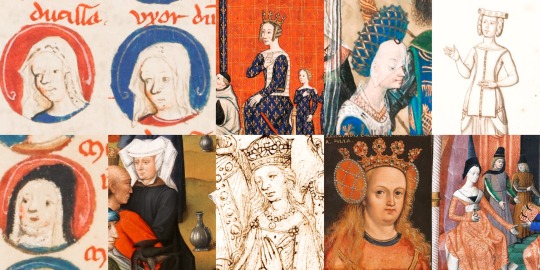
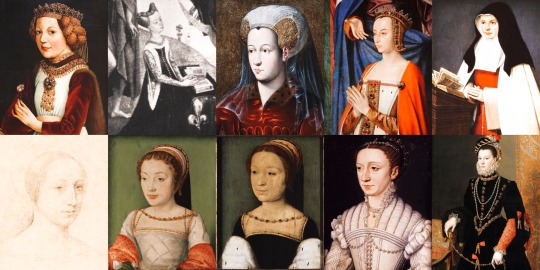
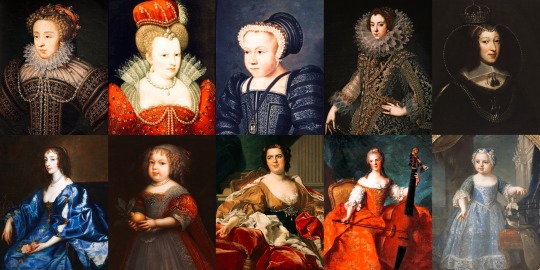

Every French princess ever
Other posts in this series: Every Queen of England ever, Every English princess ever, Every Queen of France ever
Rothilde - daughter of Charles the Bald and Richilde of Provence
Ermentrude - daughter of Louis the Stammerer and Ansgarde of Burgundy
Emma of France - daughter of Robert I and Beatrice of Vermandois (Queen consort of West Francia)
Emma of France - daughter of Robert I and Beatrice of Vermandois (Queen consort of West Francia)
Matilda of France - daughter of Louis IV and Gerberga of Saxony (Queen consort of Burgundy)
Hedwig of France - daughter of Hugh Capet and Adelaide of Aquitaine (Countess of Mons)
Gisèle of France - daughter of Hugh Capet and Adelaide of Aquitaine (Countess of Ponthieu)
Advisa of France - daughter of Robert II and Constance of Arles (Countess of Nevers)
Adela of France - daughter of Robert II and Constance of Arles (Duchess of Normandy, Countess of Flanders)
Constance of France - daughter of Philip I and Bertha of Holland (Princess of Antioch, Countess of Troyes)
Cecile of France - daughter of Philip I and Bertrade de Montfort (Princess of Galilee, Countess of Tripoli)
Constance of France - daughter of Louis VI and Adélaide of Maurienne (Countess of Boulogne and Toulouse)
Marie of France - daughter of Louis VII and Eleanor of Aquitaine (Countess of Champagne)
Alice of France - daughter of Louis VII and Eleanor of Aquitaine (Countess of Blois)
Margaret of France - daughter of Louis VII and Constance of Castile (Queen consort of England, Queen consort of Hungary and Croatia)
Alys of France - daughter of Louis VII and Constance of Castile (Countess of Vexin, Countess of Ponthieu)
Agnes of France - daughter of Louis VII and Adela of Champagne (Byzantine Empress consort)
Marie of France - daughter of Philip II and Agnes of Merania (Duchess of Brabant)
Isabelle of France - daughter of Louis VIII and Blanche of Castile (Saint)
Isabella of France - daughter of Louis IX and Margaret of Provence (Queen consort of Navarre)
Blanche of France - daughter of Louis IX and Margaret of Provence (Infanta of Castile)
Margaret of France - daughter of Louis IX and Margaret of Provence (Duchess of Brabant)
Agnes of France - daughter of Louis IX and Margaret of Provence (Duchess of Burgundy)
Blanche of France - daughter of Philip III and Maria of Brabant (Duchess of Austria)
Margaret of France - daughter of Philip III and Maria of Brabant (Queen consort of England)
Isabella of France - daughter of Philip IV and Joan I of Navarre (Queen consort of England)
Joan II of Navarre - daughter of Louis X and Margaret of Burgundy (Queen regnant of Navarre)
Joan III of Burgundy - daughter of Philip V and Joan II of Burgundy (Countess of Burgundy and Artois)
Margaret I of Burgundy - daughter of Philip V and Joan II of Burgundy (Countess of Burgundy and Artois)
Isabella of France - daughter of Philip V and Joan II of Burgundy (Dauphine of Viennois)
Blanche of France - daughter of Philip V and Joan II of Burgundy
Blanche of France - daughter of Charles IV and Joan of Évreux (Duchess of Orléans)
Joan of France - daughter of Philip VI and Blanche of Navarre
Joan of Valois - daughter of John II and Bonne of Luxembourg (Queen consort of Navarre)
Marie of France - daughter of John II and Bonne of Luxembourg (Duchess of Bar)
Isabella of France - daughter of John II and Bonne of Luxembourg (Countess of Vertus)
Catherine of France - daughter of Charles V and Joanna of Bourbon (Countess of Montpensier)
Isabella of Valois - daughter of Charles VI and Isabeau of Bavaria (Queen consort of England, Duchess of Orléans)
Joan of Valois - daughter of Charles VI and Isabeau of Bavaria (Duchess of Brittany)
Marie of Valois - daughter of Charles VI and Isabeau of Bavaria
Michelle of Valois - daughter of Charles VI and Isabeau of Bavaria (Duchess of Burgundy)
Catherine of Valois - daughter of Charles VI and Isabeau of Bavaria (Queen consort of England)
Radegonde of Valois - daughter of Charles VII and Marie of Anjou
Yolande of Valois - daughter of Charles VII and Marie of Anjou (Duchess of Savoy)
Magdalena of Valois - daughter of Charles VII and Marie of Anjou (Princess of Viana)
Joan of France - daughter of Charles VII and Marie of Anjou (Duchess of Bourbon)
Catherine of France - daughter of Charles VII and Marie of Anjou (Countess of Charolais)
Anne of France - daughter of Louis XI and Charlotte of Savoy (Duchess of Bourbon)
Joan of France - daughter of Louis XI and Charlotte of Savoy (Queen consort of France)
Claude of France - daughter of Louis XII and Anne of Brittany (Queen consort of France, Duchess of Brittany)
Renée of France - daughter of Louis XII and Anne of Brittany (Duchess of Ferrara, Modena and Reggio)
Madeleine of Valois - daughter of Francis I and Claude of France (Queen consort of Scotland)
Margaret of Valois - daughter of Francis I and Claude of France (Duchess of Berry, Duchess of Savoy)
Elisabeth of Valois - daughter of Henry II and Catherine de' Medici (Queen consort of Spain)
Claude of Valois - daughter of Henry II and Catherine de' Medici (Duchess of Lorraine)
Margaret of Valois - daughter of Henry II and Catherine de' Medici (Queen consort of France, Queen consort of Navarre)
Marie Elisabeth of France - daughter of Charles IX and Elisabeth of Austria
Elisabeth of France - daughter of Henry IV and Marie de' Medici (Queen consort of Spain, Queen consort of Portugal)
Christine of France - daughter of Henry IV and Marie de' Medici (Duchess of Savoy)
Henrietta Maria - daughter of Henry IV and Marie de' Medici (Queen consort of England)
Marie Thérèse - daughter of Louis XIV and Maria Theresa of Spain (Madame Royale)
Louise Élisabeth of France - daughter of Louis XV and Marie Leszczyńska (Duchess of Parma, Piacenza and Guastalla)
Henriette of France - daughter of Louis XV and Marie Leszczyńska
Marie Louise of France - daughter of Louis XV and Marie Leszczyńska
Marie Adélaïde de France - daughter of Louis XV and Marie Leszczyńska (Duchess of Louvois)
Victoire of France - daughter of Louis XV and Marie Leszczyńska
Sophie of France - daughter of Louis XV and Marie Leszczyńska (Duchess of Louvois)
Thérèse of France - daughter of Louis XV and Marie Leszczyńska
Louise of France - daughter of Louis XV and Marie Leszczyńska (Saint)
Marie-Thérèse - daughter of Louis XVI and Marie Antoinette (Queen consort of France)
Sophie of France - daughter of Louis XVI and Marie Antoinette
Sophie d'Artois - daughter of Charles X and Maria Theresa of Savoy
Louise of Orléans - daughter of Louis Philippe I and Maria Amalia of Naples and Sicily (Queen consort of the Belgians)
Marie of Orléans - daughter of Louis Philippe I and Maria Amalia of Naples and Sicily (Duchess of Württemberg)
Clémentine of Orléans - daughter of Louis Philippe I and Maria Amalia of Naples and Sicily (Princess of Saxe-Coburg and Gotha, Duchess of Saxony)
#french history#catherine of valois#claude of france#henrietta maria#elisabeth of valois#historical women
33 notes
·
View notes